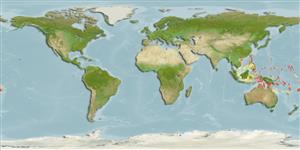Teleostei (teleosts) >
Gobiiformes (Gobies) >
Gobiidae (Gobies) > Gobiinae
Etymology: Eviota: No etymology given, suggested by Christopher Scharpt: from Latin 'eu' for 'true' and 'iota' for anything very small, in combination 'truly very small' referring to it as being the smallest vertebrate at the time it has benn described by Jenkins (thus, making the suggestion by Scharpt plausible; teresae: Named for Teresa Arámbula; in genitive case.
Eponymy: Teresa ‘Terry’ Greenfield is the senior author’s wife. She assisted in collecting the type material of the goby, and was thanked for providing field, editorial, and moral support to her husband over many years. (Ref. 128868), visit book page.
Environment: milieu / climate zone / depth range / distribution range
Ecology
Marine; reef-associated; depth range 0 - 26 m (Ref. 107299). Tropical
Indo-Pacific: collected from Fiji (Ref. 107299) and photographed from Indonesia and Maldives (J.Greenfield, pers.comm.).
Size / Weight / Age
Maturity: Lm ? range ? - ? cm
Max length : 2.1 cm SL male/unsexed; (Ref. 107299); 1.7 cm SL (female)
Short description
Identification keys | Morphology | Morphometrics
This species is distinguished by the following characters: complete cephalic sensory-canal pore pattern (pattern 1); dorsal/anal fin formula usually 9/8; pectoral-fin rays usually 18; spot lateral to pelvic-fin base absent; dark occipital spot absent; pectoral-fin base with no distinct dark pigmentation; without a dark spot on mid caudal peduncle; without transverse bars on head and nape; anal fin darker than other fins; in life, orange scale margins; presence of distinct dark spots on ventral side of head; iris reddish with scattered small light spots on dorsal surface; red blotches on sides are deeper than wide; some pectoral-fin rays are branched; fifth pelvic-fin ray about 10-15% of length of fourth ray; no membranes in pelvic fins and the branches are elongate and slender with 2 segments between branches (Ref. 107299).
Life cycle and mating behavior
Maturity | Reproduction | Spawning | Eggs | Fecundity | Larvae
Greenfield, D.W. and J.E. Randall, 2016. A review of the dwarfgobies of Fiji, including descriptions of five new species (Teleostei: Gobiidae: Eviota). J. Ocean Sci. Found. 20:25-75. (Ref. 107299)
IUCN Red List Status (Ref. 130435: Version 2024-2)
Threat to humans
Harmless
Human uses
Tools
Special reports
Download XML
Internet sources
Estimates based on models
Phylogenetic diversity index (Ref.
82804): PD
50 = 0.5000 [Uniqueness, from 0.5 = low to 2.0 = high].
Bayesian length-weight: a=0.00692 (0.00284 - 0.01683), b=3.10 (2.92 - 3.28), in cm total length, based on LWR estimates for this Genus-body shape (Ref.
93245).
Trophic level (Ref.
69278): 3.1 ±0.3 se; based on size and trophs of closest relatives
Resilience (Ref.
120179): High, minimum population doubling time less than 15 months (Preliminary K or Fecundity.).
Fishing Vulnerability (Ref.
59153): Low vulnerability (10 of 100).
Nutrients (Ref.
124155): Calcium = 486 [197, 1,628] mg/100g; Iron = 1.8 [0.7, 4.2] mg/100g; Protein = 17.5 [15.4, 19.5] %; Omega3 = 0.107 [0.033, 0.334] g/100g; Selenium = 36.6 [9.7, 120.1] μg/100g; VitaminA = 107 [19, 569] μg/100g; Zinc = 4.97 [2.55, 8.61] mg/100g (wet weight);
